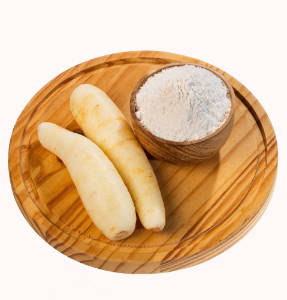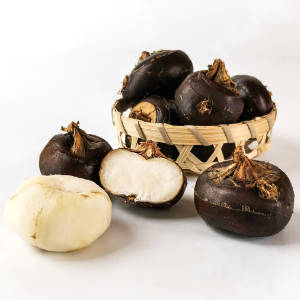Tubers & Corms Category

Technically, tubers and corms are swollen underground plant stems, but it's easier to think of them as the "family of potato-like vegetables." They're used worldwide as a source of carbohydrates, often taking a back seat to more flavorful and colorful ingredients.
arracacha
These come from South America. According to the FAO, they taste like a cross between celery, cabbage, and chestnuts.
Learn morearrowroot
The name arrowroot is more commonly associated with a thickener that's made from the plant. A fresh arrowroot tuber looks like a small onion, only without the layers. It should be peeled, and then it can be boiled or stir-fried. Look for it in Chinese markets during the winter.
Learn moreBintje potato
This is a creamy, yellow-fleshed potato that's especially good for roasting and making fries
Learn moreboiling potato
Potatoes in this category hold their shape after cooking, so they're great for making potato salads and scalloped potatoes. They're not good for mashing, baking, or making fries. Types of boiling potatoes are new potatoes, fingerling potatoes, round white potatoes, and round red potatoes.
Learn moreBoniato
Boniatos aren't as sweet and moist as other sweet potatoes, but many people prefer their fluffier consistency and more delicate flavor. Store them at room temperature and use them soon after your purchase them, since they tend to spoil quickly.
Learn moreCaribe potato
These large, starchy potatoes have purple skins and white flesh. They're great mashed, but they don't hold their shape well, so they shouldn't be used in potato salads or scalloped potatoes.
Learn morecassava
People in Hispanic countries use cassavas much like Americans use potatoes. There's both a sweet and a bitter variety of cassava. The sweet one can be eaten raw, but the bitter one requires cooking to destroy the harmful prussic acid it contains. It's often best to buy frozen cassava, since the fresh kind is hard to peel. Look for it in Hispanic markets. It doesn't store well, so use it within a day or two of purchase.
Learn moreChinese artichoke
These look a bit like caterpillars, and they taste like Jerusalem artichokes. They're popular in France but hard to find in the U.S. Your best bet would be an Asian market.
Learn morefingerling potato
There are many varieties of these small, finger-shaped potatoes, but they all tend to be low in starch, and great for roasting or making potato salads.
Learn moreJerusalem artichoke
These look like small, knobby potatoes, but they have a crisp texture and an interesting earthy flavor. You can eat them raw, stir-fry them, or bake them like potatoes. It's best not to peel them, but you'll want to scrub off the dirt. If you slice them, dunk them immediately in acidulated water to keep them from discoloring.
Learn morejicama
This tan-skinned tuber has a mild, nondescript flavor, but a nice crunchy texture. It's a good, cheap substitute for water chestnuts in stir-fries. Since it doesn't discolor, it's also a great vegetable to serve raw on a crudité platter. Peel it before using.
Learn morelong white potato
These oblong potatoes have a medium starch content, and are valued for their versatility. They're good to keep in the pantry as an all-purpose potato.
Learn moremalanga
Like taro and cassava, malanga is used in tropical countries in much the same way that potatoes are used in more temperate climates.
Learn morenew potatoes
The term "new potatoes" is sometimes used to describe all small waxy potatoes, but technically it refers just to immature potatoes harvested in the spring and early summer. You can tell if a potato is truly new by its skin; immature potatoes have flimsy, parchment-like skins that you can peel off with your fingers. New potatoes are prized for their high moisture content and creamy texture, and because they can be cooked whole. They're especially good steamed or roasted. They're more perishable than other potatoes, so use them within a few days after buying them.
Learn moreoca potato
Oca potatoes are root vegetables that are popular in New Zealand. They come in a range of colors, inclucing pink, yellow, orange and most commonly, red. Oca can be eaten raw or cooked.
Learn moreOkinawan purple potato
The flesh of this tropical Asian sweet potato is vivid purple. It's perfect for tempura, but it can also be baked, sauteed, boiled, steamed, or mashed. It is very popular in desserts in the Philippines where it is know as ube.
Learn morepurple potato
These purple-fleshed potatoes have a medium starch content, so they're good all-purpose potatoes. They lend an interesting color to mashed potatoes or potato salads, but they're not as flavorful as other varieties. They tend to get mushy if they're over-cooked.
Learn morered-skinned potato
These waxy potatoes hold their shape after they're cooked, so they're great for making potato salads and scalloped potatoes. Don't mash them--you'll end up with a sticky, gooey mess.
Learn morerusset potato
These potatoes are high in starch and low in moisture, so they bake well and yield light, fluffy mashed potatoes. They don't hold their shape after cooking, so don't use them to make potato salads or scalloped potatoes. Don't wrap them in aluminum foil while baking them; the foil traps moisture and makes the potato mushier.
Learn moresweet potato
In American supermarkets, sweet potatoes are displayed next to something called "yams," which are moister than sweet potatoes and have darker skins. But according to the rest of the world (and botanists), we have it all wrong. To them, our "yams" are just a variety of sweet potatoes. They use the word yam to describe a completely different vegetable, something we call a tropical yam. Sweet potatoes are quite versatile, but they're most often baked, candied, or made into pies. It's best not to boil them, as they'll lose much of their flavor.
Learn moretaro
If you've sampled poi at a Hawaiian luau, then you're already familiar with taro. Many people don't think much of poi, but taro can be served far more advantageously. It has an interesting, nutty flavor, and it's quite good in stews or soups, or deep-fat fried or roasted. In its raw state, it can be toxic and harsh on the skin, so wear gloves or oil your hands when handling it, and always cook it before serving it.
Learn moretropical yam
These firm, white-fleshed yams are widely used in tropical countries. They're somewhat bland and dry, so they're often served with spicy sauces.
Learn morewater chestnut
Water chestnuts are delightfully sweet and crisp--if you buy them fresh. Though canned water chestnuts are more easily available, they're not nearly as good. Look for fresh water chestnuts in Asian markets. You need to peel off their brown jackets and simmer them for five minutes before stir-frying. If you must use canned water chestnuts, blanch them first in boiling water for thirty seconds.
Learn moreyam
Americans use the word "yam" to refer to a sweet, moist, orange-fleshed variety of sweet potato. To everyone else in the world, a yam is what Americans call a tropical yam, a firm tuber with white flesh. Varieties of American "yams" (sweet potatoes) include the garnet yam (pictured at left) and the jewel yam.
Learn moreyamaimo
This is a sticky yam that the Japanese peel and grate or julienne for salads. It's also fried or used to make soba noodles.
Learn moreyellow Finn potato
These are great all-purpose potatoes, known for their yellow flesh, creamy texture, and buttery flavor.
Learn moreYukon Gold potato
These are good all-purpose potatoes that have yellow flesh and a rich flavor. They're great for boiling, but they tend to fall apart if over-cooked.
Learn more





























































































































































































































































































































































